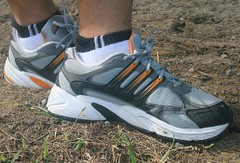The following set up can be used to investigate the effect of different light intensities, different temperatures and different carbon dioxide concentrations on the RATE of photosynthesis.
MODIFICATIONS

MODIFICATIONS
- For investigating the effect of different light intensities on the rate of photosynthesis, the distance of the light source should be altered. For example, 50cm, 40cm, 30cm, 20cm and 10cm away from the plant. Air bubbles are given out from the cut end of the plant. Allow some time for the plant to adapt to the conditions provided before taking readings. When they are coming at a regular rate, count the number of air bubbles over a period of time, say five minutes. Repeat this a few times to obtain the average rate (Note: the bubbles produced are oxygen gas released as a result of photosynthesis). The readings may be tabulated like the one shown in the following figure (The heat from the light source may affect the temperature of the water bath, so throughout the investigation, the temperature should be monitored so that it is always constant)
- To investigate the effect of different temperature on the rate of photosynthesis, the temperature of the water bath may be altered by using hot water and ice cubes.
- To investigate the effect of different carbon dioxide concentrations, sodium hydrogen carbonate solutions of different concentrations may be used. For example, 0.01M, 0.02M, 0.03M up to 0.1M.
EXPECTED OBSERVATIONS:
- Effect of different light intensities: The closer the light source to the plant, the higher the light intensity and the more bubbles will be produced and this means that the higher the rate of photosynthesis. Likewise, the further the light source away from the plant, the lower the light intensity and the less bubbles will be produced and this means that the lower the rate of photosynthesis.
- Effect of different temperatures: The lower the temperature the less bubbles will be produced and this means that the lower the rate of photosynthesis. As the temperature is increased, more and more bubbles will be produced and this indicates that the rate of photosynthesis increases with the increase in temperature. WHAT DO YOU THINK HAPPENED IF THE TEMPERATURE IS ABOVE 40 DEGREE CELSIUS? WILL THE RATE INCREASE? OR DECREASE?
- Effect of different carbon dioxide concentrations: The lower the carbon dioxide concentration, the less bubbles will be produced and this means that the lower the rate of photosynthesis. The higher the concentration of carbon dioxide, the more bubbles will be produced and this means that the higher the rate of photosynthesis.

